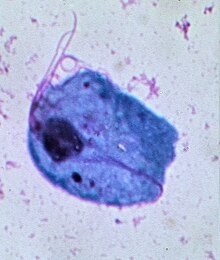| Trichomoniasis | |
|---|---|
 | |
| Micrograph showing Trichomonas vaginalis using May-Grünwald staining | |
| Specialty | Gynecology Microbiology Infectious diseases |
| Symptoms | Itching in the genital area, bad smelling thin vaginal discharge, burning with urination, pain with sex[1][2] |
| Usual onset | 5 to 28 days after exposure[1] |
| Causes | Trichomonas vaginalis (typically sexually transmitted)[2][1] |
| Diagnostic method | Finding the parasite in vaginal fluid, microbial culture, testing for the parasites DNA[1] |
| Prevention | Not having sex, using condoms, not douching[1] |
| Medication | Antibiotics (metronidazole or tinidazole)[1] |
| Frequency | 122 million (2015)[3] |
Trichomoniasis (trich) is an infectious disease caused by the parasite Trichomonas vaginalis.[2] About 70% of affected people do not have symptoms when infected.[2] When symptoms occur, they typically begin 5 to 28 days after exposure.[1] Symptoms can include itching in the genital area, a bad smelling thin vaginal discharge, burning with urination, and pain with sex.[1][2] Having trichomoniasis increases the risk of getting HIV/AIDS.[1] It may also cause complications during pregnancy.[1]
Trichomoniasis is a sexually transmitted infection (STI) most often spread by vaginal, oral, or anal sex.[1] It can also spread through genital touching (manual sex).[1] People who are infected may spread the disease even when symptoms are not present.[2] Diagnosis is by finding the parasite in the vaginal fluid using a microscope, culturing the vaginal fluid or urine, or testing for the parasite's DNA.[1] If present, other STIs should be tested for.[1]
Methods of prevention include not having sex, using condoms, not douching, and being tested for STIs before having sex with a new partner.[1] Although not caused by a bacterium, trichomoniasis can be cured with certain antibiotics (metronidazole, tinidazole, secnidazole).[1] Sexual partners should also be treated.[1] About 20% of people get infected again within three months of treatment.[2]
There were about 122 million new cases of trichomoniasis in 2015.[3] In the United States, about 2 million women are affected.[1] It occurs more often in women than men.[1] Trichomonas vaginalis was first identified in 1836 by Alfred Donné.[4] It was first recognized as causing this disease in 1916.[5]
- ^ a b c d e f g h i j k l m n o p q r s "Trichomoniasis". Office on Women's Health. August 31, 2015. Archived from the original on 27 March 2016. Retrieved 21 March 2016.
- ^ a b c d e f g "Trichomoniasis - CDC Fact Sheet". CDC. November 17, 2015. Archived from the original on 19 February 2013. Retrieved 21 March 2016.
- ^ a b Vos T, Allen C, Arora M, Barber RM, Bhutta ZA, Brown A, Carter A, et al. (GBD 2015 Disease and Injury Incidence and Prevalence Collaborators) (October 2016). "Global, regional, and national incidence, prevalence, and years lived with disability for 310 diseases and injuries, 1990-2015: a systematic analysis for the Global Burden of Disease Study 2015". Lancet. 388 (10053): 1545–1602. doi:10.1016/S0140-6736(16)31678-6. PMC 5055577. PMID 27733282.
- ^ Wiser, Mark (2010). Protozoa and Human Disease. Garland Science. p. 60. ISBN 9781136738166. Archived from the original on 2016-04-02.
- ^ Pearson, Richard D. (2001). Principles and Practice of Clinical Parasitology. Chichester: John Wiley & Sons. p. 243. ISBN 9780470851722. Archived from the original on 2016-04-02.